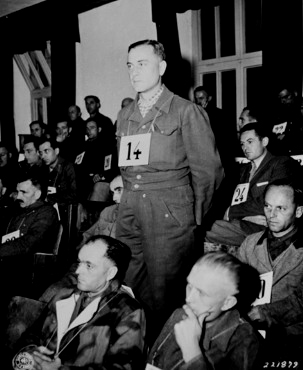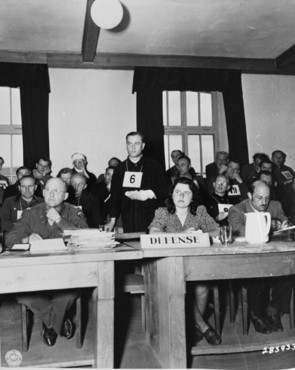Dachau Trials
US vs. Josias Erbprinz zu Waldeck-Pyrmont
The Trial of Dr. Hans Eisele

Dr. Hans Eisele stands
in the courtroom at Dachau
One of the accused in the Buchenwald
case, which was tried before an American Military Tribunal at
Dachau in 1947, was Dr. Hans Eisele who had previously been convicted
in the first Dachau trial which started in November 1945. This
was the case against former Dachau Commandant Martin Gottfried
Weiss and 39 others. Dr. Eisele had been condemned to death in
that case, but he still had to answer for crimes that he had
allegedly committed in the Buchenwald concentration camp.

SS 2nd Lt. Hans Eisele
handled his own defense at the Buchenwald trial
In the photograph above, Dr. Hans Eisele
is shown standing behind the defense table as he cross examines
a witness, acting as his own defense attorney.
According to Joshua M. Greene, author
of "Justice at Dachau," Dr. Hans Eisele was a Waffen-SS
officer who had been assigned to the Sachsenhausen concentration
camp after he was wounded at the front. At Sachsenhausen, he
was known as "the Angel" and the former prisoners gave
him a good report. He was later transferred to Dachau where his
treatment of the prisoners changed, according to Lt. Col. William
D. Denson, who prosecuted Dr. Eisele twice, once for crimes at
Dachau and then a second time for crimes committed at Buchenwald.
According to Harold Marcuse, author of
"Legacies of Dachau," Dr. Eisele had served as an SS
camp doctor successively at Natzweiler, Buchenwald, Mauthausen
and Dachau from August 1941 until the liberation of Dachau in
April 1945. He was first brought before an American Military
Tribunal as one of the 40 accused war criminals who were staff
members at Dachau. He was sentenced to death for participating
in the "common plan" to commit war crimes at Dachau,
but his sentence was commuted to life in prison because he had
only been at Dachau for 2 and 1/2 months and he had not been
personally accused of any mistreatment of the Dachau prisoners.
At Buchenwald, which was a Class II camp for hard-core Communist
political prisoners, Dr. Eisele became known as "the Butcher"
for his alleged mistreatment of the prisoners.
In the Buchenwald case, Dr. Eisele was
convicted of murdering prisoners by injection and of doing improper
surgery. He was sentenced to death again for his crimes at Buchenwald.

Dr. Hans Eisele
On June 28, 1948, a new War Crimes Board
of Review reduced Dr. Eisele's Buchenwald death sentence to life
in prison. In August 1948, another commission recommended that
his Buchenwald sentence be reduced to 10 years in prison, but
his life sentence was confirmed in December 1948.
Harold Marcuse wrote the following regarding
Dr. Eisele:
Two years later in October 1950, another
commission recommended remitting the Dachau sentence entirely,
and reducing the Buchenwald sentence to ten years with ten days
off for each month of good conduct. The recommendation was approved
and, and on 19 February 1952, Eisele was released from Landsberg.
As far as the new West German government was concerned, Eisele
had been captured and imprisoned by the enemy, so that he was
eligible for compensation payment (Heimkehrerentschädigung).
Eisele used his government award to
open a licensed family practice in Munich, where he lived untroubled
by his past until 1958, when testimony in the trial of a sadistic
Buchenwald guard before a West German court heavily incriminated
him. Warned by sympathetic officials that he would be arrested,
he personally dropped off a letter to the editor of the Munich
Evening News, in which he defended his reputation, and boarded
an airplane to Egypt, where he was employed within a network
of former Nazis in an army hospital.
The "sadistic Buchenwald guard,"
referred to above, was Martin Sommer who was in charge of the
bunker or camp prison. He was indicted by Dr. Georg Konrad Morgen
in 1943 at the same time that Commandant Koch and his wife Ilse
were put on trial. Dr. Morgen was an SS judge who was assigned
by Reichsführer Heinrich Himmler to investigate charges
of cruelty and corruption at the concentration camps. After his
trial in Dr. Morgen's court, Sommer was transferred to the Russian
front where he was wounded in action. The West German court delayed
bringing Sommer to trial until 1958 because he was a paraplegic
as a result of his war wounds. Sommer was convicted by the West
German court of the murder of 25 Buchenwald prisoners by injection
and was sentenced to life in prison. Sommer is famous as the
innovator of the hanging punishment in which prisoners were hung
by their arms from a tree. This punishment was discontinued in
1942 by order of Heinrich Himmler.
Dr. Eisele died in Egypt in 1967 at the
age of 55. His release from prison was a great disappointment
to Lt. Col. William D. Denson, the prosecutor who had twice won
his case, resulting in two death penalties for Eisele. According
to his biographer, Joshau M. Greene, Denson often spoke of Dr.
Eisele in his lectures to law students in America. Denson was
still convinced that Eisele was guilty and that his crimes became
worse and worse as he became more cruel in each new camp where
he worked. Although he had started out as a decent man before
the war, Dr. Eisele had become cruel because cruelty was commonplace
in the camps, according to Denson.
Hans
Merbach
Sentences
of the guilty
Commandant
Hermann Pister
Execution
of Communist Commissars
Ilse
Koch - human lampshades
Back
to Buchenwald trial
Back to Dachau
trials
Home
This page was last updated on September
8, 2009
Dachau TrialsUS vs. Josias Erbprinz zu Waldeck-PyrmontThe Trial of Dr. Hans Eisele One of the accused in the Buchenwald case, which was tried before an American Military Tribunal at Dachau in 1947, was Dr. Hans Eisele who had previously been convicted in the first Dachau trial which started in November 1945. This was the case against former Dachau Commandant Martin Gottfried Weiss and 39 others. Dr. Eisele had been condemned to death in that case, but he still had to answer for crimes that he had allegedly committed in the Buchenwald concentration camp.  In the photograph above, Dr. Hans Eisele is shown standing behind the defense table as he cross examines a witness, acting as his own defense attorney. According to Joshua M. Greene, author of "Justice at Dachau," Dr. Hans Eisele was a Waffen-SS officer who had been assigned to the Sachsenhausen concentration camp after he was wounded at the front. At Sachsenhausen, he was known as "the Angel" and the former prisoners gave him a good report. He was later transferred to Dachau where his treatment of the prisoners changed, according to Lt. Col. William D. Denson, who prosecuted Dr. Eisele twice, once for crimes at Dachau and then a second time for crimes committed at Buchenwald. According to Harold Marcuse, author of "Legacies of Dachau," Dr. Eisele had served as an SS camp doctor successively at Natzweiler, Buchenwald, Mauthausen and Dachau from August 1941 until the liberation of Dachau in April 1945. He was first brought before an American Military Tribunal as one of the 40 accused war criminals who were staff members at Dachau. He was sentenced to death for participating in the "common plan" to commit war crimes at Dachau, but his sentence was commuted to life in prison because he had only been at Dachau for 2 and 1/2 months and he had not been personally accused of any mistreatment of the Dachau prisoners. At Buchenwald, which was a Class II camp for hard-core Communist political prisoners, Dr. Eisele became known as "the Butcher" for his alleged mistreatment of the prisoners. In the Buchenwald case, Dr. Eisele was convicted of murdering prisoners by injection and of doing improper surgery. He was sentenced to death again for his crimes at Buchenwald.  On June 28, 1948, a new War Crimes Board of Review reduced Dr. Eisele's Buchenwald death sentence to life in prison. In August 1948, another commission recommended that his Buchenwald sentence be reduced to 10 years in prison, but his life sentence was confirmed in December 1948. Harold Marcuse wrote the following regarding Dr. Eisele: Two years later in October 1950, another commission recommended remitting the Dachau sentence entirely, and reducing the Buchenwald sentence to ten years with ten days off for each month of good conduct. The recommendation was approved and, and on 19 February 1952, Eisele was released from Landsberg. As far as the new West German government was concerned, Eisele had been captured and imprisoned by the enemy, so that he was eligible for compensation payment (Heimkehrerentschädigung). Eisele used his government award to open a licensed family practice in Munich, where he lived untroubled by his past until 1958, when testimony in the trial of a sadistic Buchenwald guard before a West German court heavily incriminated him. Warned by sympathetic officials that he would be arrested, he personally dropped off a letter to the editor of the Munich Evening News, in which he defended his reputation, and boarded an airplane to Egypt, where he was employed within a network of former Nazis in an army hospital. The "sadistic Buchenwald guard," referred to above, was Martin Sommer who was in charge of the bunker or camp prison. He was indicted by Dr. Georg Konrad Morgen in 1943 at the same time that Commandant Koch and his wife Ilse were put on trial. Dr. Morgen was an SS judge who was assigned by Reichsführer Heinrich Himmler to investigate charges of cruelty and corruption at the concentration camps. After his trial in Dr. Morgen's court, Sommer was transferred to the Russian front where he was wounded in action. The West German court delayed bringing Sommer to trial until 1958 because he was a paraplegic as a result of his war wounds. Sommer was convicted by the West German court of the murder of 25 Buchenwald prisoners by injection and was sentenced to life in prison. Sommer is famous as the innovator of the hanging punishment in which prisoners were hung by their arms from a tree. This punishment was discontinued in 1942 by order of Heinrich Himmler. Dr. Eisele died in Egypt in 1967 at the age of 55. His release from prison was a great disappointment to Lt. Col. William D. Denson, the prosecutor who had twice won his case, resulting in two death penalties for Eisele. According to his biographer, Joshau M. Greene, Denson often spoke of Dr. Eisele in his lectures to law students in America. Denson was still convinced that Eisele was guilty and that his crimes became worse and worse as he became more cruel in each new camp where he worked. Although he had started out as a decent man before the war, Dr. Eisele had become cruel because cruelty was commonplace in the camps, according to Denson. Hans MerbachSentences of the guiltyCommandant Hermann PisterExecution of Communist CommissarsIlse Koch - human lampshadesBack to Buchenwald trialBack to Dachau trialsHomeThis page was last updated on September 8, 2009 |